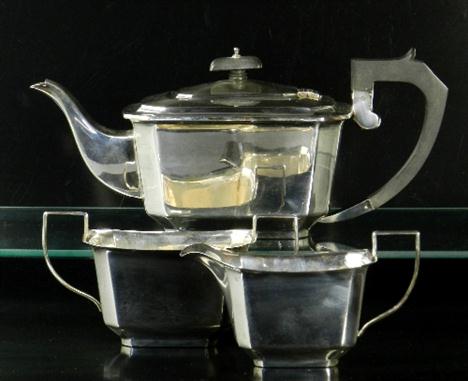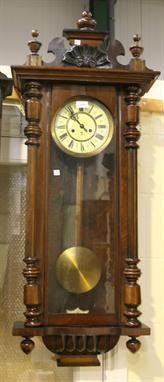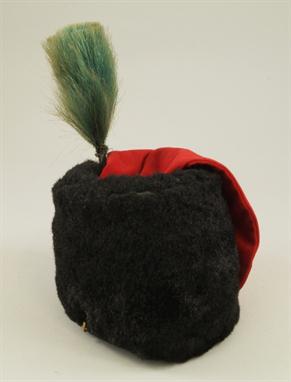A Goldsmiths and Silversmiths Co. Ltd. silver spirit kettle and burner, London 1918, the kettle of compressed circular form with repeating acanthus leaf embossed decoration to the body and engraved cartouche, the rim with scroll and foliate cast border, the hinged cover with flower head finial and the scroll handle with ivory dividers, raised on four foliate bracket feet, all upon circular stand with removable burner upon four dolphin terminal feet, with hinge and pin attachment, 31cm high, weight 66oz
We found 116041 price guide item(s) matching your search
There are 116041 lots that match your search criteria. Subscribe now to get instant access to the full price guide service.
Click here to subscribe- List
- Grid
-
116041 item(s)/page
A Victorian four piece silver tea and coffee service, William Ker Reid, London 1851, each piece of circular baluster form with engraved floral and scroll decoration, comprising; a coffee pot with flower and leaf cast finial, the handle with ivory dividers, 23.5cm high, a teapot, with flower and leaf cast finial, the handle with ivory dividers, 16cm high, a two handled sugar bowl with silver gilt interior, 8cm high and a cream jug with scroll handle and silver gilt interior, 14.5cm high, together with a pair of silver sugar nips, total weight of silver 60oz (5)
An Art Deco three piece silver tea service, Marson & Jones, Birmingham 1937, each piece of rectangular form with canted corners and raised on four stepped feet, comprising; a teapot with ebonised handle and finial, 14.5cm high, a two handled sugar bowl, 7cm high and a cream jug, 7cm high, all engraved 'DG', total weight 38oz (3)
A Japanese cast bronze two handled koro and cover, Meiji period (1860-1912), of tapering square section, the cover with immortal finial and pierced, the sides relief cast with a crane and pine tree, Asiatic pheasant, prunus, dragon, phoenix and raised on four square legs, cast four character seal mark, 42cm overall height, and a Japanese bronzed metal model of a carp, 20th century, naturalistically detailed, 32cm long (2)
A George III silver hot water jug Solomon Hougham, Solomon Royes and John East Dix, London 1818, the barrel shaped body with tapered reeding, beaded band and inverted teardrop cartouches, carved ebony handle, the shallow domed lid with further half fluting and lotus leaf and flower finial, on an outswept beaded base, 8in. (20.25cm.) high, gross weight 20oz. (624g.).
An early 19th century Irish silver lidded mustard pot maker R.Smith, Dublin 1807, of squat cauldron form with plain scroll handle, the body encircled by a band of repoussé flowers with scrolls above and below and divided by three applied lion masks, above outswept legs terminating in paws, the domed lid with floral decoration and waisted spire finial, together with an English fiddle pattern spoon, London 1806, 3 1/8in. (8cm.) high, weight 7.3oz. (229g.). (2)
A magnificent French grey marble and ormolu mantle clock c.1860, the eight day movement signed `D. Roussel, Paris, 1065` and striking on a bell, the enamelled dial with Arabic numerals, outer minutes and floral swagged decoration, pierced gilt hands, the large case with urn finial suspending ormolu floral swags over an arched top, the dial beneath on a fluted, ormolu mounted column flanked by ormolu gryphons holding further swags, on a serpentine stepped base with beaded gilt metal mounts, centred by a large ormolu figure of a maiden seated reading, on beaded gilt bun feet, 25½in. (65.5cm.) high, 19in. (48cm.) wide.
A fine 19th century French ormolu `cercle tournants` clock the `cercle tournants` movement striking on a bell, the domed cover with stiff leaf decoration and pineapple finial, encircled by a serpent, it`s forked tongue forming the hand to the rotating chapter rings beneath, with inset enamelled Roman numerals with Arabic minutes above, on an urn form case with pedestal base, also encircled by a serpent, flanked by a pair of angular loop handles suspending a husk swag, standing on a swagged fluted column with reeded and cord moulded base, on a square plinth, 21¾in. (55cm.) high * Provenance: With original invoice from Hoffman, Dealer in fine Clocks and Barometers, dated 1987.
A pair of French white marble and ormolu cassolettes late 19th century, in the Louis XVI style, each with a turned circular body with pierced rim and domed lid with cone finial, on fluted, waisted tripod supports with Bacchic masks and hoof feet, above a shaped triform base with beaded edge, on tapered feet, 12¼in. (31cm.) high. (2)
A late 19th century French ormolu and dark blue porcelain lidded urn the ovoid body having two ormolu side-mounts in the form of mermaids, separated by double floral swags conjoined by ribbon bows above a cupped circle of leaves, standing on a flared column of wrythen strapwork, on a stepped square base with incuse corners, the acanthus decorated lid with acanthus and grape finial, 17in. (43cm.) high.
A Victorian silver rectangular brooch decorated with a floral spray, Birmingham 1888, a Victorian silver pendant cross engraved with a bird, Birmingham 1897, a colourless paste set pin designed as a bird, a colourless paste set trefoil brooch, a Connemara marble set shamrock pendant, Birmingham 1898, a miniature folding knife, two balance cocks mounted as a pair of earclips, a stick pin finial, and a bracelet.
A late 19th/early 20th Century walnut Vienna style wall clock with eight day movement striking on a gong, the cream dial with black Roman numerals and inscribed `GB` (Gustav Becker), the case with scroll arch surmount and turned finial above a glazed door and tapered apron, height approx 127cm (some faults), together with a pendulum.
A George III oak longcase clock with eight day movement striking on a bell, the painted enamel break arch dial inscribed `Chas Oldham Southam` within a gilt beaded surround above Roman and Arabic numerals, subsidiary seconds and date dials cornered by gilt foliate scroll spandrels, the break arch hood surmounted with gilt ball finial above a glazed door flanked by tapering columns, the trunk door with crossbanded decoration flanked by reeded canted corners, on a similarly decorated base, height approx 225cm, with a key, pendulum and two weights.
A late 18th century North Country oak longcase clock, mahogany cross banded, having an associated 12-inch square brass dial with Roman and Arabic silvered chapter ring inscribed Robert Sadler London, seconds subsidiary dial and date aperture, decorated foliate scroll and cherub mask spandrels and set 8-day anchor movement, striking bell. The case with broken swan neck pediment flanking a globe and dart finial over plain column supports and an arch topped trunk door, raised on box base and shaped bracket feet, 210cm high x 47cm wide x 25cm deep.
A 19th century French white marble and ormolu pendule, having Arabic enamelled dial set 8 day cylinder movement, the count wheel striking bell. The case with floral urn finial upon a drum case supported by amorini, raised on plinth base decorated trophies in saltire, spreading feet 46 cm high 26cm wide x 14cm deep.
A George III Irish silver oval butter dish and cover, maker’s mark probably ‘..C’, Dublin no date, circa 1770, the cover with a vase finial, engraved with leaves and a crest to the pierced border, a rim cut recess for a knife, the base pierced open with two loop handles and with two foliate bands, engraved with a crest, 16.5cm (6 1/2in) long, 306g (9.8 oz) (the cover unmarked). The crest for ALLANSON, BIRCH, CLACK, GLEGG, HAWKINS, HORE, MARLEY, KIBBLE, WISHART and others. From the collection of Laurence W. Hodson (1863-1933) and descendants, thence by descent.
A George III English provincial oblong baluster tea pot, maker’s mark worn (possibly Reed & Sons), Newcastle circa 1815, with a ball and oblong finial to the domed cover, a leaf capped scroll handle, a gadrooned border, a reeded band and on four ball feet, 28.5cm (11 1/4in) long, 694g (22.3 oz) gross. From the collection of Laurence W. Hodson (1863-1933) and descendants, thence by descent.
A silver twin handled trophy cup and cover by William Comyns & Sons Ltd, London 1913, with a baluster finial and lambrequin decoration to the domed cover, scroll handles, the body engraved with an armorial, a motif and a presentation inscription ‘The British Masters Thorpe Park’, lambrequin lower decoration and on a circular moulded spreading foot, 28cm (11in) high, 2587g (83.15 oz). The shield bears the arms of MORLEY and other quarters.
A George III silver oblong sauce tureen and cover by Rebecca & William Emes, London 1808, with a lobed circular finial to the domed cover, twin angular handles, a nulled rim and on four ball feet, 20.5cm (8in) long, 576g (18.5 oz). The mark entered on 30th June 1808 and only used until 14th October the same year.. From the collection of Laurence W. Hodson (1863-1933) and descendants, thence by descent.
A George IV silver baluster coffee jug by Robert Hennell II, London 1824, with a cast seated chinaman finial, a wide chased floral band to the cover and a similarly decorated band to the lower body, an ivory loop handle, engraved with an armorial, 19cm (7 1/2in) high, 603g (19.4 oz) gross. Engraved with a lozenge for a spinster of the family KEMEYS-TYNTE. The arms of KEMEYS quartering TYNTE with further quarters for JOHNSON, HASSELL and WHARTION pertain to a family originally seated in Halswell, Somerset and in Cefn Mably, Glamorganshire. Following the incumbency (1707-1740) of Rev. Sir John Tynte, 5th baronet, numerous hatchments for members of this family were erected in the parish church of Goathurst, Kent. In 1845 a Committee of Privileges of the House of Lords declared Charles Kemeys-Tynte, MP for Bridgwater, senior co-heir of the whole blood to the Barony of Wharton.
A George III silver oblong baluster three piece tea service by Robert I & Samuel Hennell, London 1809, the tea pot with a composition oval finial to the half lobed dome centred cover, a composition harp handle, the egg and dart rim with scroll foliate angles, a half lobed body and on four ball feet, engraved with a crest, 28cm (11in) long, 1347g (43.3 oz) gross. The crest of MADDOCKS of Suffolk.
A George III silver swollen circular coffee biggin by Robert and Samuel Hennell, London 1802, with a lobed finial to the slightly domed cover, a wooden loop handle and with reeded borders, engraved with an armorial; together with a silver heating stand by Peter Podio, London, 1792, similarly decorated, on three supports with pad legs, 29cm (11 1/2in) high overall, 802g (25.75 oz) gross. The arms of HEYWOOD of Heywood, Lancashire recorded in 1664.
A George II silver tapering coffee pot by Thomas Moore II, London 1752, with a bell finial to the domed cover, a later fruitwood double scroll handle, the spout chased with acanthus leaves and on a circular moulded spreading foot, 22cm (8 1/2in) high, 640g (20.6 oz) gross. From the collection of Laurence W. Hodson (1863-1933) and descendants, thence by descent.
-
116041 item(s)/page




























































